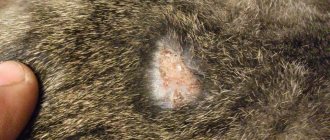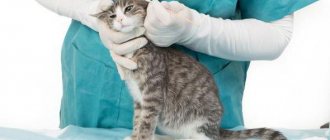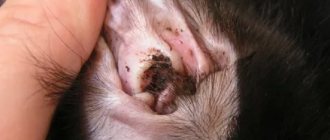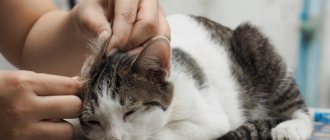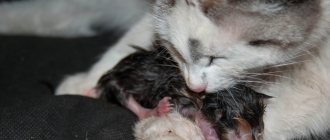It is always a good idea to take a closer look at the condition of your furry pet. The slightest changes in his behavior and/or appearance are the most important indicators that can indicate in advance the development of dangerous pathologies.
For example, small bald patches on a cat's face could be a sign of poor nutrition... or something more serious. For example, a fungus appears on a cat’s chin, some pathogens of which pose a serious danger to the life and health of your pet.
Causes of fungus
It is believed that strange bald patches on the chin may be a sign of ringworm (ringworm). This is a common group of fungal skin diseases that practicing veterinarians encounter very often.
Most pathogens of mycoses (for example, the Trichophyton fungus) have very high virulence, causing disease even in animals with a relatively normal immune system. Moreover, lichens are extremely dangerous because they are not species specific.
Remember! When interacting with a sick cat, both you and your family members risk getting sick. Other pets, including dogs, hamsters and other animals, can easily become infected.
But! Note that, regardless of the cause (i.e., the specific type of pathogen), the development of the disease is greatly facilitated by poor feeding, stress and allergies. These factors adversely affect the state of the animal's immune system.
Ringworm causes hair loss (hairs break off near the root), erythema and baldness. One of the distinguishing signs of many types of lichen is the appearance of round bald areas on the skin, in the center of which there is a red spot. Such lesions strongly resemble cigarette burns in their appearance.
Despite the presence of relatively specific symptoms, diagnosing dermatomycosis can be very difficult, sometimes dragging on for several weeks (the pathogen grows very slowly on nutrient media). The sooner the owner notices that something is wrong with his pet, the greater the chance of quickly treating the cat and avoiding infection himself.
Cats: alopecia associated with itching. Part 1
Causes of alopecia (baldness) in cats and other skin diseases: read part 2: Skin diseases and alopecia in cats not associated with itching
Hair loss in cats, lichen, demodicosis, hypotrichosis
Baldness of cats,
The appearance of hairless areas on your beloved cat is a common reason for visiting a veterinarian. The first thought that usually arises among owners is guard, lichen!!! Sometimes frightened owners can send an unfortunate animal to the street without trial... Meanwhile, there are a huge number of reasons for hair loss in cats, and we will try to talk about the most common ones: dermatophytosis, trichophytosis, microsporia (lichen).
What is alopecia?
This is an area on the skin that, for some reason, has lost its hair.
Types of alopecia in cats
Alopecia can be diffuse, focal and localized. Diffuse – when hair falls out abundantly and all over the body, partial – when in several areas. Localized - when only one area is affected.
Hair loss: spontaneous or self-induced
A very important point that you need to pay attention to for a correct diagnosis is whether the hair loss is independent or self-induced. Correctly self-induced alopecia is called “Spontaneous”, with this type of hair falling out on its own.
Self-induced or self-induced alopecia occurs from licking, for example, with itching and self-injury.
Due to constant grooming and constant licking, in some especially clean cats it is often not clear what kind of alopecia it is. Observing the cat helps most; the owner notices that the cat has begun to lick certain places intensively.
If some owners spend too much time outside the house or if cats hide, it can be difficult to understand. In this case, the doctor will take several hairs for a trichogram - analysis of hair under a microscope. Hairs that fall out on their own have bulbs at the end, but when you lick the hair on your own, it becomes injured and the ends look like broken off.
Sometimes in very difficult cases, for diagnosis, it is recommended to wear an “Elizabethan” collar, which makes self-licking impossible.
Determining what type of hair loss is significantly narrows down the list of differential diagnoses.
Hypotrichosis
There is also such a thing as hypotrichosis
- when the amount of hair on the skin area is reduced. Visually, it looks like a “bruised/moth-eaten” or like a thinning bald spot, when the skin is visible under the remnants of hair.
Ways of transmission of fungal infection
Despite the increased virulence of many mycoses, an important role in infection/non-infection is played by the physiological state of the animal, its nutritional characteristics, and the presence or absence of strong stress factors.
The main route of transmission is direct contact between a healthy animal and a sick animal. In such cases, the infection rate exceeds 70% (i.e., if you come into contact with a sick cat, your pet has a 70% chance of becoming infected). In addition, fungal spores can end up on bedding, toys, brushes, clothing, gloves of owners, or even on fleas.
It is interesting that no one has conducted in-depth studies of the transmission of lichen using ectoparasites, but practicing veterinarians are 100% sure that this route of transmission is more than real.
Accordingly, the development of the disease is greatly facilitated by cramped living conditions. It is not surprising that in many cat shelters the infection rate of animals can quickly reach 100%. Despite this, the question still remains about the likelihood of infection after a single contact of a cat with contaminated care items.
But here, most likely, the main role is played by the number of transmitted spores. So, there probably won’t be a lot of them left on the scissors, but on the comb there will be plenty of “seeds” of the pathogen. The same goes for litter and cat baskets. You should only select new ones for your pet, or purchase them only from owners of guaranteed healthy animals.
Symptoms of fungus in cats
Since primary symptoms often go unnoticed, in practice we often have to deal with already complicated (secondary bacterial infections) lichens. Alas, in such situations, animals not only have bald patches on the chin and other parts of the body: everything is much more serious.
Extensive foci of inflammation and scabs appear on the skin, and abundant exudate is visible from the ulcerated areas. The remaining fur becomes matted and turns into “icicles”, being glued together by the exudate. It is possible to develop infections of the upper respiratory tract and oral cavity (also fungal or secondary bacterial).
Please note that it is strongly recommended to cut sick pets, as there may be even more fungal lesions under the fur.
Detailed description of possible causes
If a cat loses hair on its chin after black spots, red pimples, lumps or pink sores appear on it, then the reason may lie in scratching, since all of the above is accompanied by severe itching. Baldness of this area of the face in cats is almost always accompanied by accompanying symptoms that are difficult not to notice, as they cause a lot of discomfort to the animal. Especially in cases associated with an acute allergic reaction. Most often, this symptom is considered together with the following pathologies:
- Eosinophilic granulomas. Many veterinarians believe that eosinophilic granuloma can be caused by all types of allergies (food, atopic dermatitis, reaction to parasite saliva). Symptoms occur differently in each individual case. In some cases, single formations appear, sometimes the lesions spread to large areas of the skin. In many cases, chin hair loss in cats is caused by eosinophilic granuloma, which can be complicated by a secondary infection. First, the process develops against the background of redness of a separate area of the skin (usually the chin, lip, nose, less often the cheeks or ears). Then one or more pink plaques appear, slightly rising above the surface of the skin. For some, they are accompanied by severe itching; there are also cases when the formations do not bother the pet at all. Frequent licking of the lips and nose is also considered characteristic symptoms. Treatment in each case is individual, which should be based on local remedies and anti-inflammatory drugs. But, success will greatly depend on eliminating the provoking factor. Given that most allergies are not cured once and for all, exacerbations of eosinophilic granuloma in a pet can occur many times throughout its life. Good effectiveness was shown by daily treatment of the affected areas with a chlorhexidine solution (2-3 times a day), changing the brand of food, and eliminating plastic dishes from the animal’s diet.
- Lichen. It is more common in kittens and animals living outdoors. It is considered a contagious disease that can be transmitted to dogs and even humans. In rare cases, it occurs with minimal manifestations in the form of small spots on the skin. But, the most common form occurs when there is severe itching and hair loss. Most often the chin, ears, head are affected, and less commonly the limbs and tail. The spots can reach the size of a large coin. There is no fur inside the spot and there is weeping. There is almost always a flaky rim along the edges. If the animal reaches the lesions, it can lick or scratch them until they bleed. To make a diagnosis, an external examination of the animal by a veterinarian is required. Next, he will take scrapings from the lesions for microscopic and cytological examination. Good effectiveness is shown by glowing a cat under a Wood's lamp, where fungal spores will glow emerald. If the presence of fungal spores is confirmed, then depending on the severity of the symptoms and the age of the pet, treatment with antifungal drugs will be prescribed. Kittens under 8 weeks of age are prescribed only bathing with antifungal shampoos (Mikozoral, Perhotal, Nizoral, Imaverol). Adults are recommended to be treated with oral antifungal drugs (Terbinafine, Fungin). The duration of the course and dosage are prescribed by the veterinarian for each animal individually. Separately, it is necessary to write about the opinion of the majority of leading veterinarians in the country - vaccinations against lichen Vakderm and Polivac are not effective. It is recommended to pay special attention to disinfection of the premises and objects with which the infected animal comes into contact. For this purpose, products can be used that are marked as effective in killing dermatophytes. To speed up treatment and reduce the risk of spores spreading throughout the apartment, it is recommended to trim the sick animal.
Diagnostics
The most accurate method, which makes it possible to make a diagnosis with 100% probability, is growing a culture of the pathogen on a special nutrient medium, followed by microscopy. The problem is that fungi take a very long time to grow. Therefore, for “emergency” diagnostics, the so-called Wood’s lamp is often used. The idea is that some strains of dermatomycetes begin to fluoresce under UV radiation. True, this method does not always work.
In addition, the diagnosis is made on the basis of data obtained from conventional microscopy of hair samples and scrapings from the animal’s skin. In this case, it is highly advisable to tint the samples and conduct the study using oil lenses. In this case, the image in the field of view is more contrasting, and therefore it is much easier to detect the pathogen.
Symptoms
A healthy cat's fur is smooth, shiny, firmly held in the skin, and the coat itself is not ruffled.
With the development of alopecia, areas of baldness can be complete or partial, located symmetrically or not. In some cases, the animal may scratch these areas, and the skin here may be hot and red.
Rice. 2. Partial alopecia on the back of a cat.
In skin diseases or behavioral disorders, alopecia is symmetrical on the trunk, forelimbs, thighs, sides or abdomen. The age and gender of the animal do not matter.
When stress occurs, hairs broken and torn out by the cat itself are found in the back, on the limbs, stomach and inner thighs, near the genitals and anus. Cats of “nervous” breeds are especially susceptible: Siamese, Burmesse, Himalayan and Abyssinian. These breeds will have darker hair color after restoration.
In case of hormonal imbalances, alopecia is observed in the area of the bridge of the nose, croup, base of the tail, hips, and chest. The skin loses its elasticity.
And if there is a lack of thyroid hormones in a cat, hair in the area of the pelvic bones is easily pulled out by the roots. Such alopecia, including asymmetrical ones, are recorded on the abdomen, chest and neck. The cover is restored with difficulty.
With malignant tumors, there is a complete absence of hair shafts on the abdomen, alopecia quickly spreads to the chest and limbs, and then can affect the entire surface of the skin. At the same time, the skin on the affected areas shines.
With vitamin deficiency A, alopecia areata develops: spots without hair, round in shape, form on the skin, which merge to form large alopecias. The skin has a bright pink color.
With microscopic fungi (trichopytosis, microsporia), hairless areas of the skin are reddened and may have scales and crusts, scabs and wounds.
With scabies, redness, itching, and in particularly advanced cases, purulent inflammation of the skin are observed. Dermatitis is accompanied by an increase in local body temperature, scratching, the appearance of pimples, etc.
If the course of alopecia is unfavorable, an infection may occur, and then an inflammatory process develops on the skin.




